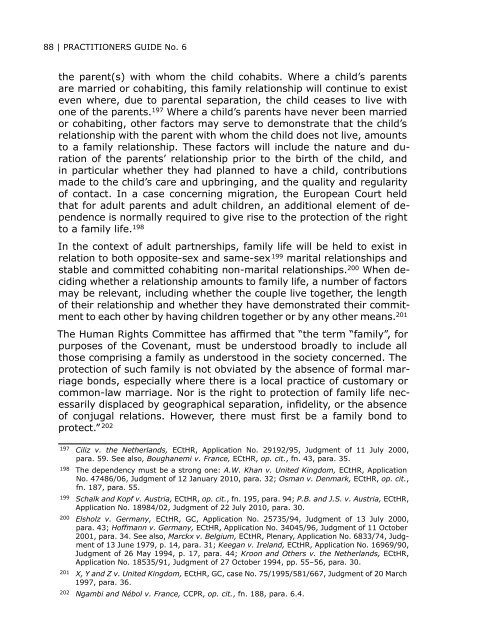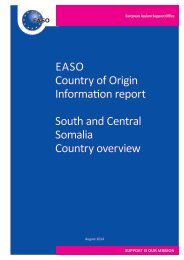- Page 1 and 2:
Migration andInternational Human Ri
- Page 3 and 4:
Migration andInternational Human Ri
- Page 5 and 6:
MIGRATION AND INTERNATIONAL HUMAN R
- Page 7 and 8:
MIGRATION AND INTERNATIONAL HUMAN R
- Page 9 and 10:
MIGRATION AND INTERNATIONAL HUMAN R
- Page 11 and 12:
MIGRATION AND INTERNATIONAL HUMAN R
- Page 13 and 14:
MIGRATION AND INTERNATIONAL HUMAN R
- Page 15 and 16:
MIGRATION AND INTERNATIONAL HUMAN R
- Page 17 and 18:
MIGRATION AND INTERNATIONAL HUMAN R
- Page 19 and 20:
MIGRATION AND INTERNATIONAL HUMAN R
- Page 21 and 22:
MIGRATION AND INTERNATIONAL HUMAN R
- Page 23 and 24:
MIGRATION AND INTERNATIONAL HUMAN R
- Page 25 and 26:
MIGRATION AND INTERNATIONAL HUMAN R
- Page 27 and 28:
MIGRATION AND INTERNATIONAL HUMAN R
- Page 29 and 30:
MIGRATION AND INTERNATIONAL HUMAN R
- Page 31 and 32:
MIGRATION AND INTERNATIONAL HUMAN R
- Page 33 and 34:
MIGRATION AND INTERNATIONAL HUMAN R
- Page 35 and 36:
MIGRATION AND INTERNATIONAL HUMAN R
- Page 37 and 38:
MIGRATION AND INTERNATIONAL HUMAN R
- Page 39 and 40:
MIGRATION AND INTERNATIONAL HUMAN R
- Page 41 and 42:
MIGRATION AND INTERNATIONAL HUMAN R
- Page 43 and 44:
MIGRATION AND INTERNATIONAL HUMAN R
- Page 45 and 46:
MIGRATION AND INTERNATIONAL HUMAN R
- Page 47 and 48:
MIGRATION AND INTERNATIONAL HUMAN R
- Page 49:
MIGRATION AND INTERNATIONAL HUMAN R
- Page 52 and 53:
36 | PRACTITIONERS GUIDE No. 6of ri
- Page 54 and 55: 38 | PRACTITIONERS GUIDE No. 6the i
- Page 56 and 57: 40 | PRACTITIONERS GUIDE No. 6• A
- Page 58 and 59: 42 | PRACTITIONERS GUIDE No. 6heigh
- Page 60 and 61: 44 | PRACTITIONERS GUIDE No. 6worke
- Page 62 and 63: 46 | PRACTITIONERS GUIDE No. 6activ
- Page 64 and 65: 48 | PRACTITIONERS GUIDE No. 6rent
- Page 66 and 67: 50 | PRACTITIONERS GUIDE No. 6CHAPT
- Page 68 and 69: 52 | PRACTITIONERS GUIDE No. 6terri
- Page 70 and 71: 54 | PRACTITIONERS GUIDE No. 6the U
- Page 72 and 73: 56 | PRACTITIONERS GUIDE No. 6The A
- Page 74 and 75: 58 | PRACTITIONERS GUIDE No. 6ii) G
- Page 76 and 77: 60 | PRACTITIONERS GUIDE No. 6gende
- Page 78 and 79: 62 | PRACTITIONERS GUIDE No. 6Note
- Page 80 and 81: 64 | PRACTITIONERS GUIDE No. 6A lim
- Page 82 and 83: 66 | PRACTITIONERS GUIDE No. 6The U
- Page 84 and 85: 68 | PRACTITIONERS GUIDE No. 6Box 3
- Page 86 and 87: 70 | PRACTITIONERS GUIDE No. 6be su
- Page 88 and 89: 72 | PRACTITIONERS GUIDE No. 6right
- Page 90 and 91: 74 | PRACTITIONERS GUIDE No. 6the a
- Page 92 and 93: 76 | PRACTITIONERS GUIDE No. 6isfy
- Page 94 and 95: 78 | PRACTITIONERS GUIDE No. 6In pa
- Page 96 and 97: 80 | PRACTITIONERS GUIDE No. 6and i
- Page 98 and 99: 82 | PRACTITIONERS GUIDE No. 6It is
- Page 100 and 101: 84 | PRACTITIONERS GUIDE No. 6Under
- Page 102 and 103: 86 | PRACTITIONERS GUIDE No. 6lies
- Page 106 and 107: 90 | PRACTITIONERS GUIDE No. 6evolv
- Page 108 and 109: 92 | PRACTITIONERS GUIDE No. 6also
- Page 110 and 111: 94 | PRACTITIONERS GUIDE No. 6permi
- Page 112 and 113: 96 | PRACTITIONERS GUIDE No. 6es in
- Page 114 and 115: 98 | PRACTITIONERS GUIDE No. 6State
- Page 116 and 117: 100 | PRACTITIONERS GUIDE No. 65. S
- Page 118 and 119: 102 | PRACTITIONERS GUIDE No. 6Unde
- Page 120 and 121: 104 | PRACTITIONERS GUIDE No. 6tion
- Page 122 and 123: 106 | PRACTITIONERS GUIDE No. 6they
- Page 124 and 125: 108 | PRACTITIONERS GUIDE No. 6CHAP
- Page 126 and 127: 110 | PRACTITIONERS GUIDE No. 6has
- Page 128 and 129: 112 | PRACTITIONERS GUIDE No. 6for
- Page 130 and 131: 114 | PRACTITIONERS GUIDE No. 6prot
- Page 132 and 133: 116 | PRACTITIONERS GUIDE No. 6to s
- Page 134 and 135: 118 | PRACTITIONERS GUIDE No. 6ment
- Page 136 and 137: 120 | PRACTITIONERS GUIDE No. 6also
- Page 138 and 139: 122 | PRACTITIONERS GUIDE No. 6nati
- Page 140 and 141: 124 | PRACTITIONERS GUIDE No. 6(iv)
- Page 142 and 143: 126 | PRACTITIONERS GUIDE No. 6char
- Page 144 and 145: 128 | PRACTITIONERS GUIDE No. 6In t
- Page 146 and 147: 130 | PRACTITIONERS GUIDE No. 6this
- Page 148 and 149: 132 | PRACTITIONERS GUIDE No. 6thro
- Page 150 and 151: 134 | PRACTITIONERS GUIDE No. 6In t
- Page 152 and 153: 136 | PRACTITIONERS GUIDE No. 6proh
- Page 154 and 155:
138 | PRACTITIONERS GUIDE No. 6mate
- Page 156 and 157:
140 | PRACTITIONERS GUIDE No. 6just
- Page 158 and 159:
142 | PRACTITIONERS GUIDE No. 6“p
- Page 160 and 161:
144 | PRACTITIONERS GUIDE No. 63. t
- Page 162 and 163:
146 | PRACTITIONERS GUIDE No. 6Furt
- Page 164 and 165:
148 | PRACTITIONERS GUIDE No. 6poss
- Page 166 and 167:
150 | PRACTITIONERS GUIDE No. 6CHAP
- Page 168 and 169:
152 | PRACTITIONERS GUIDE No. 6proc
- Page 170 and 171:
154 | PRACTITIONERS GUIDE No. 6the
- Page 172 and 173:
156 | PRACTITIONERS GUIDE No. 6expu
- Page 174 and 175:
158 | PRACTITIONERS GUIDE No. 6Box
- Page 176 and 177:
160 | PRACTITIONERS GUIDE No. 6•
- Page 178 and 179:
162 | PRACTITIONERS GUIDE No. 6have
- Page 180 and 181:
164 | PRACTITIONERS GUIDE No. 6At t
- Page 182 and 183:
166 | PRACTITIONERS GUIDE No. 6Box
- Page 184 and 185:
168 | PRACTITIONERS GUIDE No. 6The
- Page 186 and 187:
170 | PRACTITIONERS GUIDE No. 6exec
- Page 188 and 189:
172 | PRACTITIONERS GUIDE No. 6huma
- Page 190 and 191:
174 | PRACTITIONERS GUIDE No. 6“i
- Page 192 and 193:
176 | PRACTITIONERS GUIDE No. 6Arti
- Page 194 and 195:
178 | PRACTITIONERS GUIDE No. 6to r
- Page 196 and 197:
180 | PRACTITIONERS GUIDE No. 6suff
- Page 198 and 199:
182 | PRACTITIONERS GUIDE No. 6Righ
- Page 200 and 201:
184 | PRACTITIONERS GUIDE No. 6•
- Page 202 and 203:
186 | PRACTITIONERS GUIDE No. 6vent
- Page 204 and 205:
188 | PRACTITIONERS GUIDE No. 6One
- Page 206 and 207:
190 | PRACTITIONERS GUIDE No. 6tion
- Page 208 and 209:
192 | PRACTITIONERS GUIDE No. 6orde
- Page 210 and 211:
194 | PRACTITIONERS GUIDE No. 6ICCP
- Page 212 and 213:
196 | PRACTITIONERS GUIDE No. 6gans
- Page 214 and 215:
198 | PRACTITIONERS GUIDE No. 6one
- Page 216 and 217:
200 | PRACTITIONERS GUIDE No. 6his
- Page 218 and 219:
202 | PRACTITIONERS GUIDE No. 6For
- Page 220 and 221:
204 | PRACTITIONERS GUIDE No. 6c) A
- Page 222 and 223:
206 | PRACTITIONERS GUIDE No. 6the
- Page 224 and 225:
208 | PRACTITIONERS GUIDE No. 6race
- Page 226 and 227:
210 | PRACTITIONERS GUIDE No. 6ing
- Page 228 and 229:
212 | PRACTITIONERS GUIDE No. 6left
- Page 230 and 231:
214 | PRACTITIONERS GUIDE No. 6judi
- Page 232 and 233:
216 | PRACTITIONERS GUIDE No. 6b) R
- Page 234 and 235:
218 | PRACTITIONERS GUIDE No. 6upon
- Page 236 and 237:
220 | PRACTITIONERS GUIDE No. 6well
- Page 238 and 239:
222 | PRACTITIONERS GUIDE No. 6•
- Page 240 and 241:
224 | PRACTITIONERS GUIDE No. 6Wher
- Page 242 and 243:
226 | PRACTITIONERS GUIDE No. 6CHAP
- Page 244 and 245:
228 | PRACTITIONERS GUIDE No. 6This
- Page 246 and 247:
230 | PRACTITIONERS GUIDE No. 6The
- Page 248 and 249:
232 | PRACTITIONERS GUIDE No. 6law
- Page 250 and 251:
234 | PRACTITIONERS GUIDE No. 6a re
- Page 252 and 253:
236 | PRACTITIONERS GUIDE No. 6Huma
- Page 254 and 255:
238 | PRACTITIONERS GUIDE No. 6the
- Page 256 and 257:
240 | PRACTITIONERS GUIDE No. 6same
- Page 258 and 259:
242 | PRACTITIONERS GUIDE No. 6civi
- Page 260 and 261:
244 | PRACTITIONERS GUIDE No. 6As f
- Page 262 and 263:
246 | PRACTITIONERS GUIDE No. 6priv
- Page 264 and 265:
248 | PRACTITIONERS GUIDE No. 6•
- Page 266 and 267:
250 | PRACTITIONERS GUIDE No. 6has
- Page 268 and 269:
252 | PRACTITIONERS GUIDE No. 6The
- Page 270 and 271:
254 | PRACTITIONERS GUIDE No. 6allo
- Page 272 and 273:
256 | PRACTITIONERS GUIDE No. 6stre
- Page 274 and 275:
258 | PRACTITIONERS GUIDE No. 6is c
- Page 276 and 277:
260 | PRACTITIONERS GUIDE No. 6educ
- Page 278 and 279:
262 | PRACTITIONERS GUIDE No. 6CHAP
- Page 280 and 281:
264 | PRACTITIONERS GUIDE No. 6ther
- Page 282 and 283:
266 | PRACTITIONERS GUIDE No. 6not
- Page 284 and 285:
268 | PRACTITIONERS GUIDE No. 6•
- Page 286 and 287:
270 | PRACTITIONERS GUIDE No. 6also
- Page 288 and 289:
272 | PRACTITIONERS GUIDE No. 6Wher
- Page 290 and 291:
274 | PRACTITIONERS GUIDE No. 6•
- Page 292 and 293:
276 | PRACTITIONERS GUIDE No. 6port
- Page 294 and 295:
278 | PRACTITIONERS GUIDE No. 6The
- Page 296 and 297:
280 | PRACTITIONERS GUIDE No. 6irre
- Page 298 and 299:
282 | PRACTITIONERS GUIDE No. 6any
- Page 300 and 301:
284 | PRACTITIONERS GUIDE No. 6serv
- Page 302 and 303:
286 | PRACTITIONERS GUIDE No. 6d) P
- Page 304 and 305:
288 | PRACTITIONERS GUIDE No. 6Cent
- Page 306 and 307:
290 | PRACTITIONERS GUIDE No. 6ANNE
- Page 308 and 309:
292 | PRACTITIONERS GUIDE No. 6ANNE
- Page 310 and 311:
294 | PRACTITIONERS GUIDE No. 6of w
- Page 312 and 313:
296 | PRACTITIONERS GUIDE No. 6Amer
- Page 314 and 315:
298 | PRACTITIONERS GUIDE No. 6righ
- Page 316 and 317:
300 | PRACTITIONERS GUIDE No. 6of a
- Page 318 and 319:
302 | PRACTITIONERS GUIDE No. 6a re
- Page 320 and 321:
304 | PRACTITIONERS GUIDE No. 6prov
- Page 322 and 323:
306 | PRACTITIONERS GUIDE No. 6one,
- Page 324 and 325:
308 | PRACTITIONERS GUIDE No. 6When
- Page 326 and 327:
310 | PRACTITIONERS GUIDE No. 6Ther
- Page 328 and 329:
312 | PRACTITIONERS GUIDE No. 6•
- Page 330 and 331:
314 | PRACTITIONERS GUIDE No. 6the
- Page 332 and 333:
316 | PRACTITIONERS GUIDE No. 6dire
- Page 334 and 335:
318 | PRACTITIONERS GUIDE No. 6II.
- Page 336 and 337:
320 | PRACTITIONERS GUIDE No. 6Comm
- Page 338 and 339:
322 | PRACTITIONERS GUIDE No. 6Admi
- Page 340 and 341:
324 | PRACTITIONERS GUIDE No. 6fina
- Page 342 and 343:
326 | PRACTITIONERS GUIDE No. 63. E
- Page 344 and 345:
328 | PRACTITIONERS GUIDE No. 6asks
- Page 346 and 347:
330 | PRACTITIONERS GUIDE No. 6The
- Page 348 and 349:
332 | PRACTITIONERS GUIDE No. 6subm
- Page 350 and 351:
334 | PRACTITIONERS GUIDE No. 6ligh
- Page 352 and 353:
336 | PRACTITIONERS GUIDE No. 6The
- Page 354 and 355:
338 | PRACTITIONERS GUIDE No. 6a) B
- Page 356 and 357:
340 | PRACTITIONERS GUIDE No. 6resp
- Page 358 and 359:
342 | PRACTITIONERS GUIDE No. 6Spec
- Page 360:
344 | PRACTITIONERS GUIDE No. 6(d)
- Page 364:
ISBN 978-92-9037-151-X



